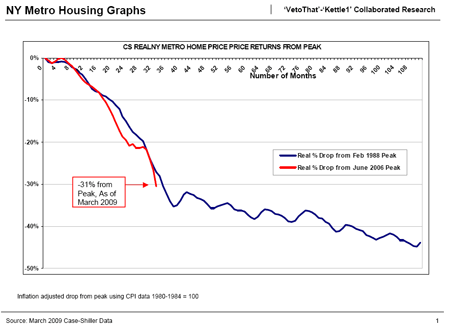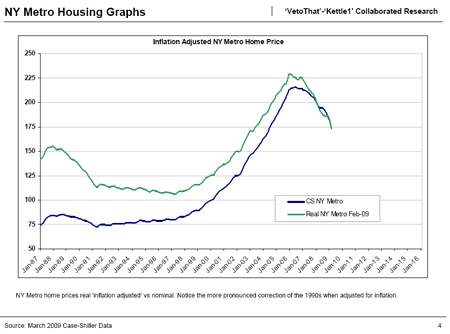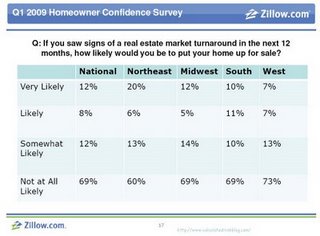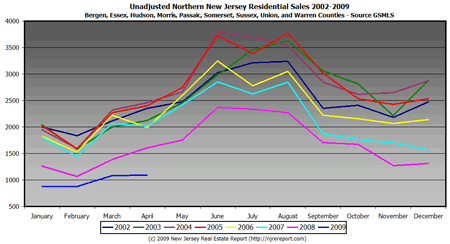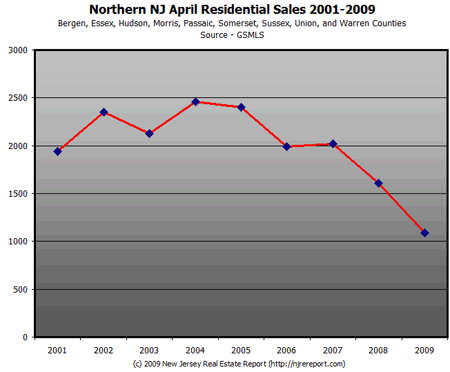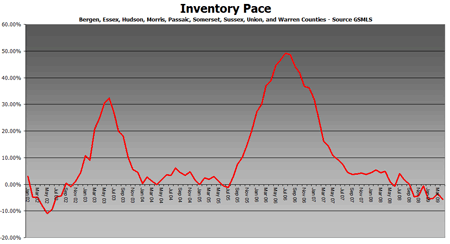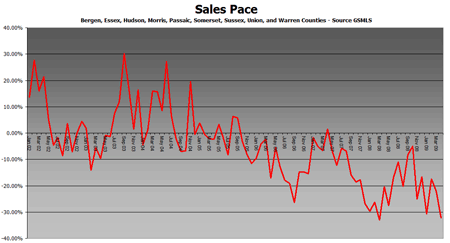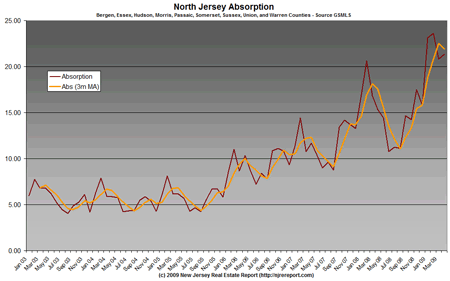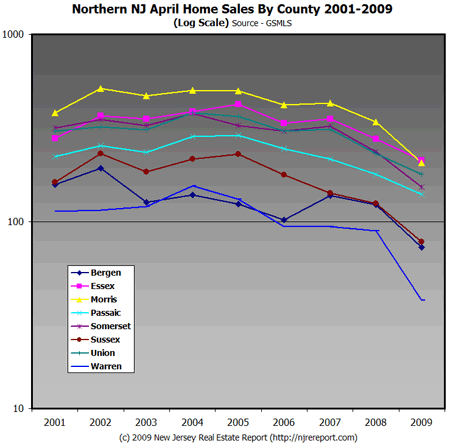From the National Association of Realtors:
2009 Q1 Metropolitan Area Single Family Prices
Year over Year Single Family Price Changes (By MSA)
United States -13.8% (for reference)
Northeastern US -15.9% (for reference)
Allentown-Bethlehem-Easton, PA-NJ -8.0%
Atlantic City, NJ -21.0%
New York-Northern New Jersey-Long Island, NY-NJ-PA -16.0%
New York-Wayne-White Plains, NY-NJ -12.8%
NY: Edison, NJ -11.3%
NY: Nassau-Suffolk, NY -18.6%
NY: Newark-Union, NJ-PA -12.5%
Philadelphia-Camden-Wilmington, PA-NJ-DE-ME -6.7%
Trenton-Ewing, NJ -12.4%
2009 Q1 Metropolitan Area Condo Prices
Year over Year Condo Price Changes (By MSA)
United States -20.2% (for reference)
Northeastern US -11.9% (for reference)
New York-Wayne-White Plains, NY-NJ -15.4%
NY: Edison, NJ -11.4%
NY: Nassau-Suffolk, NY -8.1%
NY: Newark-Union, NJ-PA -14.7%
Philadelphia-Camden-Wilmington, PA-NJ-DE-ME -2.8%
Trenton-Ewing, NJ -7.9%
2009 Q1 Total Sales: Single-Family, Condos, Co-ops
Year over Year Total Sales (By State)
United States -6.8% (for reference)
Northeastern US -20.1% (for reference)
New Jersey -18.7%
New York -23.1%
Pennsylvania -18.8%
From the Record:
Home prices drop in North Jersey in 1Q
Home prices dropped almost 13 percent in the New York metropolitan area, which includes North Jersey, in the first quarter of 2009 from the same period a year ago, the National Association of Realtors said today.
According to the real estate trade group, home prices in the area that includes Bergen, Passaic and Hudson counties, as well as New York City, fell to $429,900, down from $492,800 a year earlier.
And the volume of home sales in New Jersey plummeted 18.7 percent from the first quarter of 2008. Sales were running at a a seasonally adjusted annual rate of 93,400 in the first quarter of 2009 — about half the 180,000-plus annual sales during the housing boom in 2004 and 2005.
From Reuters:
US 1st qtr median home prices slide from year ago
The National Association of realtors said on Tuesday that home prices dropped in 134 out of 152 metro areas on a year-over-year basis during the first quarter of this year.
The national median price for an existing single-family home was $169,000, some 13.8 percent below the price in the first quarter of 2008. The median is the half-way point, with half the prices above and half below this level.
The realtors’ lobby group said foreclosures and short sales were keeping prices down.
“Many buyers sought deeply discounted distressed sales — foreclosures and short sales — which accounted for nearly half of transactions in the first quarter and weighed down median prices in most markets,” the realtors said.
From Bloomberg:
Home Prices in U.S. Drop Most on Record in Quarter
Home prices in the U.S. dropped the most on record in the first quarter from a year earlier, led by California and Florida, as banks sold foreclosed properties.
The median price fell 14 percent to $169,000, the National Association of Realtors said today. Prices dropped in 134 of 152 metropolitan areas, with the deepest declines in Cape Coral and Ft. Myers, Florida, followed by San Francisco and San Jose.
…
“There are a lot of forces pushing the market in different directions,” said Brian Bethune, economist at IHS Global Insight in Lexington, Massachusetts. “We’ve seen huge improvements in affordability, not only in prices but also in terms of mortgage rates below 5 percent, but what’s pushing down those prices is foreclosures and job losses.”
From the Wall Street Journal:
U.S. Median House Price Declines 14%
The median price for a single-family house fell 14% to $169,000 in the first quarter from a year earlier, the National Association of Realtors reported.
The trade group said first-time home buyers accounted for half of all purchases in the quarter, and many of them zeroed in on foreclosed homes. That dragged down the median, the Realtors said.
The median price for the latest quarter is down 26% from a peak of $227,600 in the third quarter of 2005. The latest median price was down from a year earlier in 134 of the 152 metro areas included in the survey.
…
Sales of single-family homes and condominiums declined 6.8% from a year earlier to a seasonally adjusted annual rate of 4.6 million units. But sales were up sharply in some areas hardest hit by the housing bust, largely because bargain hunters were out in force. States with big sales increases from the depressed levels of a year before included Nevada (up 117%), California (81%) and Arizona (50%) and Florida (25%).
Rising unemployment and fears of more job losses are deterring many potential buyers. But others are encouraged by the lowest mortgage rates since the 1950s. In addition, the U.S. government is offering tax credits for certain home buyers before Dec. 1.

